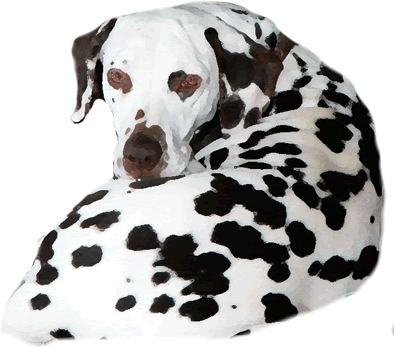Q: Do I need to breed to a Pointer?
A: Absolutely and emphatically, no. The single Dalmatian – Pointer cross was done over 34 years ago, and the subsequent dozen or more generations have produced 99.8% purity. This work does not need to be repeated. All you need to do is to find an LUA Descendant that appeals to you, and move forward from there.
Q: Does the LUA phenotype persist through adulthood?
A: Yes. The presence of the dominant LUA gene (U) in the DNA will always code for the metabolic machinery to produce Low Uric Acid throughout the lifespan of the LUA Descendant. The genetic makeup does NOT change from birth to death.
Q: Is a special diet required for an LUA Descendant?
A: No. A nutritionally beneficial canine diet is all that is needed. There is no need to worry about protein level, water intake, etc., other than what would be true for any dog.
Q: Will I need to practice specific management procedures to maintain the health and wellness of my LUA Descendant?
A: No. The care of an LUA Decendent is the same as for any dog.
Q: Will my LUA Descendants develop any Pointer health problems?
A: No. There are no known Pointer specific health issues noted in LUA Descendants after more than 34 years of breeding in over 12 generations. After those 12 generations, the contribution of Pointer DNA is less than 2 hundredths of one percent – very, very, very little.
Q: Can I establish the LUA dominant gene in my breeding line?
A: Yes. Mate to an LUA Descendant, select an LUA puppy and proceed from there with your breeding program. It is like breeding for black spotting from a liver factored Dal mated to a liver Dal – 1/2 of the litter will be black.
Q: What are the major health issues in Dalmatians? Are they the same in LUA Descendants?
A: The major breed specific health issues in Dalmatians are urate stones and hearing deficits. In LUA Descendants, the chance of forming urate stones is addressed but the hearing deficits remain.
Q: Are uric acid stones a problem in Dalmatians?
A: Yes. Many pet owners, breeders and veterinarians face day-to-day decisions in reference to the health of the Dalmatians in their care. Hydration and diet concerns are constantly worked with, and the uric acid problem still leads to obstructions and even death in the Dalmatian.
Q: Can uric acid crystals and stones be easily managed?
A: No. These High Uric Acid characteristics must be constantly addressed by control of the protein and purine content in the food, by liberal access to water, and by attention to other environmental details such as wetting (floating) the kibble, avoiding certain abnormalities of water content, crating duration, etc. They are not, therefore, “easy” to manage.
Q: How may I prove to myself my AKC registered Dalmatian is HUA?
A: A spot urine test for urinary uric acid to urinary creatinine ratio is one way, but the easiest is to collect a sample of urine from your dog, put it into a clear cup in the refrigerator, and after it is thoroughly cooled, look at the contents. You will see that the urine has changed from clear yellow to a milky, opaque consistency, which is evidence that the high uric acid content has precipitated out.
Q: How may I prove to myself that my LUA breeding has resulted in the creation of an LUA Descendant?
A: The DNA testing will validate the presence (or absence) of the low urinary uric acid dominant gene (U) in your puppy (puppies). A spot urine determination of urinary uric acid to urinary creatinine ratio is also a helpful screening test.
Q: Where may I get these tests performed? What samples or specimens are needed?
A: The University of California at Davis School of Veterinary Medicine is currently the only lab offering DNA testing from dewclaws at present. Spot urine analysis for urinary uric acid to urinary creatinine ratio may be completed at a variety of labs.
Q: If I breed to an 8th generation LUA Descendant, what percentage Dalmatian “blood” will theoretically be present in my puppies?
A: 99.61%
Q: If I breed to a 12th generation LUA Descendant, what percentage Dalmatian “blood” will theoretically be present in my puppies?
A: 99.98%

Home | History | Basics | Health | Meet The LUA'S | Pedigrees | Publications | Statistics | FAQS | Breeders | Contact
Home | History | Basics | Health | Meet The LUA'S | Pedigrees | Publications | Statistics | FAQS | Breeders | Contact
